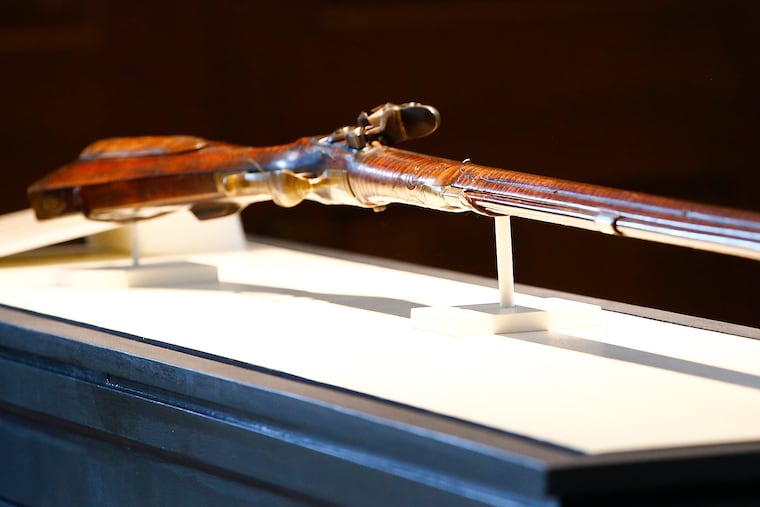Rare Revolutionary-era rifle recovered nearly 50 years after brazen theft from Valley Forge
Stolen in a brazen, broad daylight heist at Valley Forge National Historical Park in 1971, this relic of America's cultural history might have been lost forever were it not for an eagle-eyed antiques dealer at a barn sale last year.

In 1971, a thief walked into the visitor center at Valley Forge National Historical Park just minutes after it opened for the day, used a crowbar to open a display case, and sneaked off with a priceless piece of America’s heritage.
The whereabouts of the Revolutionary-era flintlock rifle that vanished that day remained a mystery for nearly 50 years.
But on Friday, federal and local authorities announced they had recovered the filched firearm — one of the few surviving works of Pennsylvania master gun-maker John Christian Oerter — and returned it to its rightful owners.
“This rifle and its ownership are important reminders of who we are and how we got here,” said Assistant U.S. Attorney K.T. Newton at a ceremony to mark the recovery at the Museum of the American Revolution. “This moment is that rare thing — it’s pure good news — and a reminder of the many levels of good citizenship that have evolved in this country.”
Investigators with the FBI’s art crime team credited Adams County, Pa., antiques dealer Kelly Kinzle with discovering the rifle at a barn sale in Berks County last year.
“I actually thought it was a reproduction,” Kinzle said Friday. “My first inclination was that it had to be fake, because the real gun isn’t going to show up in a barn in today’s world. Things like that are already in collections.”
But after purchasing the firearm, examining it, and realizing its historical significance, he contacted his attorneys. One of his lawyers, Albert Oehrle, linked the rifle to the theft at Valley Forge years earlier, Kinzle said. Along with attorney Jay Robert Stiefel, they contacted the FBI and began negotiating a handover.
Kinzle declined to say Friday from whom he bought the rifle, citing the ongoing investigation. But he said it was unlikely the previous owner — whom he described as a “hoarder” rather than a collector — had any idea what he was selling.
Investigators with the FBI, Upper Merion Police Department, and Montgomery County Detectives have spent the 13 months since recovering the weapon attempting to trace it back to the person who stole it in 1971, FBI art crime investigator Jacob Archer said.
But while that investigation continues, they decided to return the firearm to the Pennsylvania Society of Sons of the Revolution, the organization that donated it to Valley Forge for display in 1963.
It will be put on display at the Museum of the American Revolution starting next week.
“These are weapons that after being used to win the war were brought home and used to build a nation,” said R. Scott Stephenson, the museum’s president. “They really are witnesses not just to the founding of the nation but to all the generations that followed.”
Historians have described the firearm — a five-foot rifle, stamped with its 1775 date of manufacture, decorated with a brass-wire fleur-de-lis on the wrist, and engraved on its stock with the name “W. Goodwin” — as a prime specimen of a late 18th century style known as the “flintlock Kentucky long rifle,” popularized by frontiersmen like Daniel Boone.
The guns proved instrumental in the American war effort, allowing colonial soldiers to shoot more accurately and from farther away than their British counterparts, who carried smooth-bore muskets. Some scholars credit the colonists’ ultimate victory to the more advanced firearms carried by their troops.
But despite associations with the Bluegrass State, most flintlock long rifles of the period were manufactured in Moravian settlements in what is today Northampton County, Pa. And Oerter, a master riflemaker, ran one of the busiest gun manufacturing outfits in Christian’s Spring, near present-day Nazareth, during the war.
Known for their elaborate silver and brass wire inlays and carved decorations, Oerter’s firearms are recognized by arms scholars as some of the finest and most important of the period.
The rifle the FBI returned Friday is only one of two signed and dated examples of Oerter’s work known to still exist. The other, housed in the Royal Collection at Windsor Castle, was given in the early 1800s to the future King George IV, then the Prince of Wales, by a British cavalry officer who served in the war.
The Pennsylvania Society of Sons of the Revolution loaned its Oerter rifle to Valley Forge Park, where it was displayed starting in 1963.
A Boy Scout touring Valley Forge with his troop noticed that the rifle had vanished from its aquarium-size glass display case eight years later.
At the time, investigators determined the thief entered the visitor center just after 9 a.m. on the morning of Oct. 2, forced open the case, and walked out with the weapon while a receptionist sat unaware in the next room.
The Inquirer reported that authorities waited nearly a month to publicly disclose the heist out of fear that whoever had taken the gun — insured for more than $15,000 — might panic when its value was realized and destroy it.
Though the trail ran cold, a pair of Upper Merion police detectives reopened the investigation a decade ago and continue to pursue leads generated by the rifle’s discovery, Montgomery County District Attorney Kevin R. Steele said.
But for now, he added, “this significant piece of American Revolutionary history is now back where it belongs, displayed in a museum to be viewed and enjoyed by all Americans.”